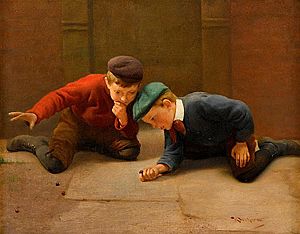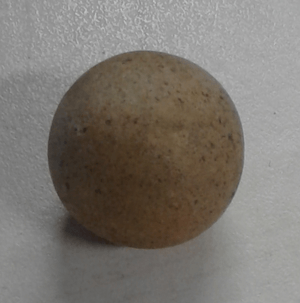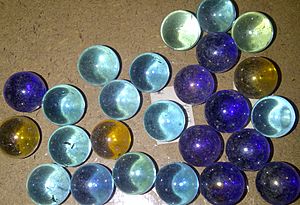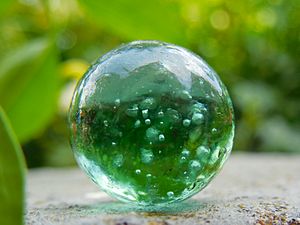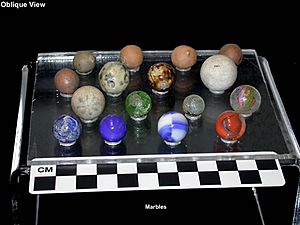Marbles (game) facts for kids
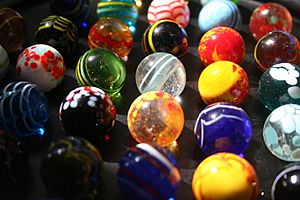
Marbles is a fun game played by children using small, round glass balls. These balls are also called 'marbles'.
Marbles come in different sizes. Most are about 1/2 inch to 1 inch (1.3 to 2.6 cm) wide. But some can be tiny, less than 1/30 inch (0.111 cm), or very big, over 3 inches (7.75 cm).
As you can see in the pictures, these little glass balls are often very pretty. Many children enjoy collecting them. In some parts of Northern England, both the marbles and the game are called 'taws'.
The game of marbles has been played in many countries for a long time. The rules often change depending on who is playing. One common way to play is to have a target marble. Players flick their own marble with their thumbnail, trying to hit the target. Another way is to try and knock other players' marbles out of a special playing area.
Marbles have a long history! They were found in very old civilizations like Mohenjo-daro, Ancient Egypt, and Rome.
Contents
The World of Marbles: Tinsley Green Championship
The game of marbles has been played in Tinsley Green, West Sussex, England, for many centuries. Some records suggest it started as early as 1588.
The British and World Marbles Championship has taken place in Tinsley Green every year since 1932. The first championship in 1932 was won by a team from a local pub called the Black Horse in nearby Charlwood.
Traditionally, the marbles season began on Ash Wednesday. It lasted until midday on Good Friday. People believed playing after that time brought bad luck. Today, more than 20 teams from all over the world join the championship each Good Friday. German teams have won many times since the year 2000. Local teams from places like Crawley, Copthorne, and other villages in Sussex and Surrey also compete.
Discovering Different Types of Marbles
There are many different kinds of marbles. Their names can change from one place to another. Here are some popular types:
- Aggie: These are made from agate stone or glass that looks like agate. They often have cool patterns.
- Alley or Real: Made of marble or alabaster stone. They have wavy patterns with fun names like corkscrew or spiral.
- Cat's eye or Catseye: These marbles have a colored "eye" shape inside them.
- Beachball: A cat's eye marble with three colors and six vanes.
- Devil's eye: A red marble with a yellow eye.
- Lutz: An old, handmade German marble. It has shiny copper flakes inside that look like gold.
- Oilie or Oily: These marbles are not see-through and have a rainbow, shiny surface.
- Onionskin: Another old, handmade German marble. It has many close streaks on its surface.
- Opaque: A very common marble that comes in many solid colors.
- Toothpaste: These marbles have wavy streaks, often in colors like red, blue, black, white, or orange.
- Cat's eye or Catseye: These marbles have a colored "eye" shape inside them.
- Bumblebee: A modern marble, usually yellow with two black stripes.
- China: Made of glazed porcelain. They have patterns similar to alley marbles. Some rare ones have flowers.
- Plaster: A type of china marble that is not glazed.
- Commie or Common: Made of clay. They are either natural clay color or one solid color.
- Crystal or Clearie or Purie: Any clear colored glass marble. They can be called "deep blue sea" or "green ghost."
- Galaxy: A modern marble with many dots inside, looking like a sky full of stars.
- Indian: An old, handmade German marble. It is dark and not see-through, usually black. It has colored bands on top, often white and other colors.
- Mica: An old, handmade German marble. It is clear or see-through with shiny mica flakes inside.
- Steely: Made of steel. A real steely is folded from a flat piece of steel.
- Sulphide: An old, handmade German marble. It is a large clear glass ball, often 1.25 to 3 inches (3 to 7.75 cm) wide. Inside, it has a small figure or statuette. Most often, you'll find animals like dogs or cats. Human figures are rare.
- Swirly: A common glass marble with one swirly color.
- Shooter: Any marble that is larger than normal, used for shooting.
- Tiger: A clear marble with orange-yellow stripes.
- Baby: A white marble with colors that you can see on the outside.
- Tom Bowler: A very large glass marble, at least twice the size of a regular marble.
Collecting Marbles: A Fun Hobby
Many people who played marbles as kids grow up to become marble collectors. When collecting marbles, people look at many things. These include how good the marble's condition is, its size, type, and who made it. They also consider its age, style, and what it's made of. How rare it is and if it comes in its original package also matter.
A marble's value mostly depends on its type, size, condition, and how appealing it looks. How many are available and how many people want them also play a role. Sometimes, a marble that isn't very pretty but is very rare can be worth a lot. But usually, a marble's condition is the most important thing. If a marble has any damage, like chips or pits, its value can drop by half or more.
Because so many people collect marbles, many related businesses have started. There are books and guides about marbles. Websites host live auctions just for marbles. There are even collector conventions where people meet. Also, many glass artists create special "art marbles" just for collectors. Some of these can sell for thousands of dollars!
How Marbles Are Made
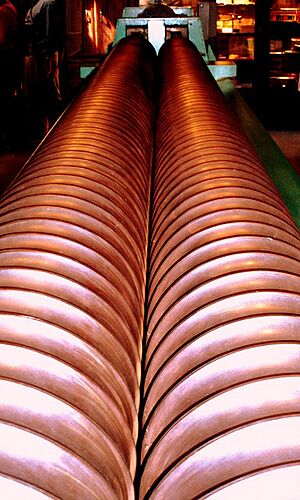
Marbles are made using different methods. They can be made by hand or by machine.
Originally, marbles were all made by hand. Stone or ivory marbles could be shaped by grinding them. Marbles made from Clay, pottery, ceramic, or porcelain are made by rolling the material into a ball. Then, they are left to dry or are baked in a kiln. After baking, they can be left natural, painted, or glazed. Clay marbles, sometimes called crock marbles or commies, are made from slightly porous clay. This clay often came from local sources or leftover earthenware. They are rolled into balls, then glazed and baked at a low heat. This creates a not-so-perfect, opaque ball.
Machines also make marbles. One way is by dropping hot, melted glass into a special groove. This groove is made by two parallel screws that fit together. As the screws turn, the marble moves along them. It slowly gets shaped into a perfect sphere as it cools down. Colors are added to the glass in different ways. For example, in "cat's-eye" marbles, colored glass is injected into clear glass. Sometimes, more expensive colored glass is put on the surface of cheaper clear or white glass.
Where Marbles Are Made Around the World
Today, the biggest maker of playing marbles in the world is Vacor de Mexico. This company makes 90 percent of all the marbles in the world. They produce over 12 million marbles every single day!
Marbles are also made in China. Some marbles, especially older ones or those from certain places, might contain materials that aren't good for you, so it's always smart to be careful.
Images for kids
See also
 In Spanish: Canica para niños
In Spanish: Canica para niños



